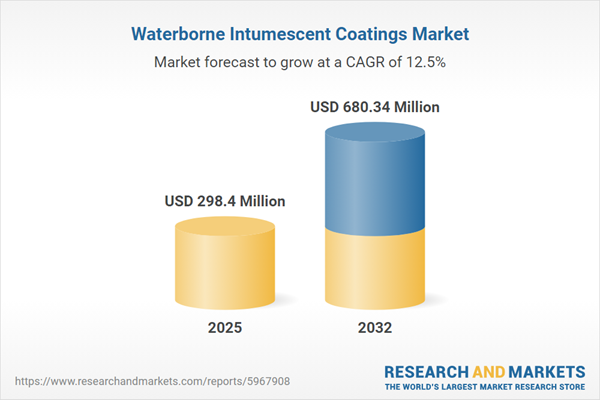Speak directly to the analyst to clarify any post sales queries you may have.
The waterborne intumescent coatings market is demonstrating strong momentum, responding to new sustainability mandates, evolving safety regulations, and increasing demand from the construction and industrial sectors. Senior leaders can leverage these developments to enhance safety standards, support environmental goals, and strengthen competitive advantage in diverse global markets.
Market Snapshot: Waterborne Intumescent Coatings Market Growth
The Waterborne Intumescent Coatings Market grew from USD 265.17 million in 2024 to USD 298.40 million in 2025. With expectations of continued robust growth at a CAGR of 12.49%, the market is projected to reach USD 680.34 million by 2032. This trajectory underscores the increasing relevance of waterborne intumescent coatings as a choice for passive fire protection systems across critical infrastructure, commercial, and industrial assets.
Scope & Segmentation
This research provides comprehensive analysis across the following categories and regions:
- End Use Industry: Automotive, Commercial Buildings, Infrastructure, Marine, Oil & Gas, Power Generation
- Resin Type: Acrylic, Epoxy, Polyurethane, Silicon
- Application: Intermediate Coat, Primer, Top Coat
- Technology: One-Component, Two-Component
- Sales Channel: Direct Sales, Distributors, Online
- Regions: Americas (United States, Canada, Mexico, Brazil, Argentina, Chile, Colombia, Peru), Europe, Middle East & Africa (United Kingdom, Germany, France, Russia, Italy, Spain, Netherlands, Sweden, Poland, Switzerland, United Arab Emirates, Saudi Arabia, Qatar, Turkey, Israel, South Africa, Nigeria, Egypt, Kenya), Asia-Pacific (China, India, Japan, Australia, South Korea, Indonesia, Thailand, Malaysia, Singapore, Taiwan)
- Leading Companies: The Sherwin-Williams Company, PPG Industries Inc., Akzo Nobel N.V., Jotun A/S, Hempel A/S, RPM International Inc., Axalta Coating Systems Ltd., BASF SE, Nippon Paint Holdings Co., Ltd., Carboline Company
Key Takeaways for Senior Decision-Makers
- Waterborne intumescent coatings use water as their primary carrier, providing significant reductions in volatile organic compound emissions and supporting compliance with stringent environmental regulations.
- Advancements in resin chemistries—including acrylic, epoxy, polyurethane, and silicon—have improved adhesion, char strength, and thermal performance, enabling reliable protection in critical applications.
- Growing preferences among manufacturers and specifiers for green building certifications, coupled with the need for sustainable fire protection, are driving the transition away from solvent-based systems.
- Digital innovation is enhancing product selection and application efficiency, supporting tailored fire protection strategies and streamlined quality assurance processes for complex projects.
- Rapid industrial and infrastructure expansion in Asia-Pacific and urban growth in the Middle East & Africa are presenting new opportunities and competitive challenges for suppliers equipped with scalable, compliant solutions.
Tariff Impact: US Trade Policy Developments
The newly enacted United States tariffs targeting key resin and specialty additive imports are reshaping cost structures and supply chains. Stakeholders are adapting procurement and sourcing strategies to address import duties, considering alternative chemistries and engaging with domestic partners to maintain cost competitiveness. These conditions favor regional production capabilities and may increase attention to recycled and secondary raw materials.
Methodology & Data Sources
This report leverages a rigorous mixed-method research design. Primary research comprised structured interviews and workshops with manufacturers, suppliers, end users, and safety specialists. Secondary sources included regulatory filings, technical journals, patent databases, and supply chain data. Cross-referencing multiple data streams, including scenario modeling and peer review, ensures validity in the findings.
Why This Report Matters
- Enables senior decision-makers to benchmark strategic initiatives against technological, regulatory, and market trends in global fire protection.
- Offers actionable insights on supply chain risk mitigation, sustainability integration, and competitive differentiation within the protective coatings industry.
- Empowers leadership to anticipate evolving requirements in key end-use sectors, from automotive fire safety to infrastructure resilience and green commercial buildings.
Conclusion
Waterborne intumescent coatings are integral to the convergence of safety, environmental responsibility, and innovation in protective coatings. Companies adopting robust supply strategies and advanced solutions can capture opportunity in this dynamic market environment.
Additional Product Information:
- Purchase of this report includes 1 year online access with quarterly updates.
- This report can be updated on request. Please contact our Customer Experience team using the Ask a Question widget on our website.
Table of Contents
3. Executive Summary
4. Market Overview
7. Cumulative Impact of Artificial Intelligence 2025
Companies Mentioned
The companies profiled in this Waterborne Intumescent Coatings market report include:- The Sherwin-Williams Company
- PPG Industries, Inc.
- Akzo Nobel N.V.
- Jotun A/S
- Hempel A/S
- RPM International Inc.
- Axalta Coating Systems Ltd.
- BASF SE
- Nippon Paint Holdings Co., Ltd.
- Carboline Company
Table Information
| Report Attribute | Details |
|---|---|
| No. of Pages | 187 |
| Published | October 2025 |
| Forecast Period | 2025 - 2032 |
| Estimated Market Value ( USD | $ 298.4 Million |
| Forecasted Market Value ( USD | $ 680.34 Million |
| Compound Annual Growth Rate | 12.4% |
| Regions Covered | Global |
| No. of Companies Mentioned | 11 |









